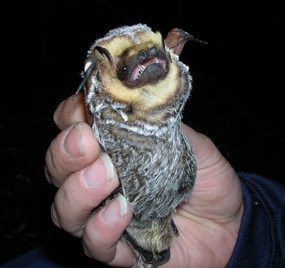
Photo by Jennifer Linehan
Vicksburg National Military Park has been under the jurisdiction of the National Park Service (NPS) for over seventy years. But as is the case with most other national parks, a concerted effort on the part of the NPS to comprehensively inventory the animals and plants located within the parks did not begin until 2000. Thus it was not until 2005 that Vicksburg was able to arrange for a formal survey to be made of its mammalian fauna. To accomplish this the NPS contracted with academic experts from the University of Georgia to perform the study. As of this writing, the final results from their work are not yet available. But some preliminary findings are known. Fifty-three species of mammal are known to occur in Warren County, the county in which the vast majority of the park is located. Most of these species were found to also reside in or utilize park lands. Many of these are animals that are common to eastern deciduous forests such as white-tailed deer, Virginia oppossums, spotted skunks, eastern chipmunks, and racoons. Also present are domestic dogs and cats that have escaped from the surrounding city and county into the park. Some visit the site but return to their owners' homes for proper meals and care. However, others have become feral residents of the park, breeding together and perpetuating themselves. (It is safe to say that during the Civil War feral cats and dogs were not uncommon to the area, as Vicksburg was a settled community even back then.) One of the park's more notable, though seldom seen, mammal species is the bobcat. Unfortunately these creatures are finding their habitat is continually shrinking as the county and city lands surrounding the park continue to develop. A regrettable incident occurred in 2004 when a bobcat was struck and killed by a car on one of the main thoroughfares through the park. Traffic and animals are a combination that does not mix, and it is almost always the animals that suffer from the encounter. There is another type of mammal that has become well known to park staff ranging from naturalists to historians to maintenance personnel. These are bats, particulary one species of bat that has taken up residence in one of the park's major monuments! Up to thirty big brown bats (Eptesicus fuscus) use the carved inlaid sculpture encircling the inside of the Illinois Memorial as roosting habitat. (The memorial is a domed building of Greco-Roman design that is permanently open at its top.) The bats' droppings, or guano, collects below them, making it necessary for maintenance staff to regularly clean the memorial's walls and floor. However, no attempt has been made to remove the bats because it is thought that the memorial is such a perfect "cave" for them that more bats would quickly replace any that were evicted. Not all resident bats are using the park's tourist attractions as a home. But in another interesting case of bats using man-made structures for roosts, several evening bats (Nycticeius humeralis) that had been captured and radio-tagged by researchers were found to return to perches in utility poles following their nighttime flights. This may be a case where wild animals are adapting to the human-dominated world around them. |
Last updated: April 14, 2015
